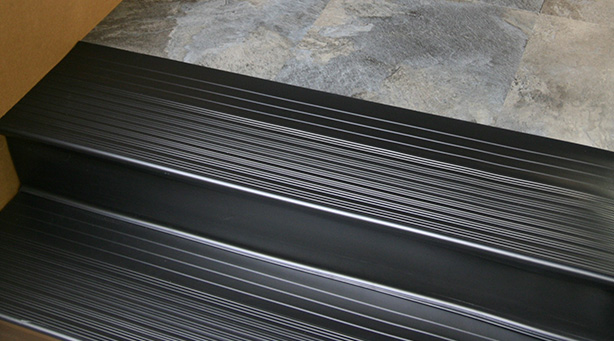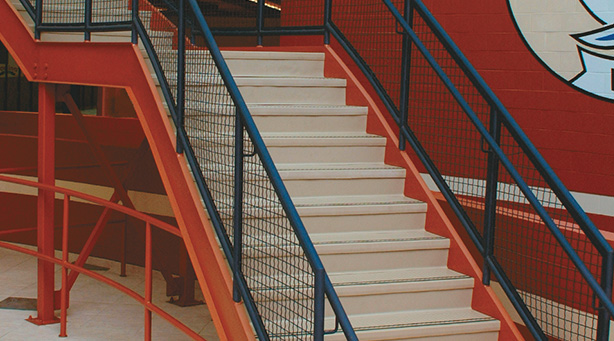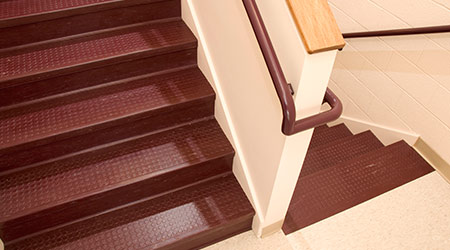SPONSORED
Musson Rubber - Branded Feature
Proper Installation a Key in Stair Tread Safety and Lifecycle
Staircase safety is a concern for most building facility managers. Covering steps with a commercial grade rubber or vinyl stair tread will add safety features to help eliminate slips and falls.
Proper maintenance is a key in keeping the covered steps safe; regular sweeping with a soft hair broom and prompt cleanup of spills are necessary to keep the steps safe. But stair safety begins with the installation of the stair tread; proper installation will not only keep the steps safe but will also increase the life cycle of the stair treads.
Proper preparation of the stairs are the first step to a successful installation along with the selection of the proper tread for the configuration of the steps and the nature of the application. Repairing worn or uneven edges, making sure the stairs are clean and dry, and maintaining the proper room temperature are necessary for a proper installation. But proper preparation is just the first step.

Most stair tread replacements are due to a cracked nose on the tread, usually about ¾” from the front edge of the step. This cracking of the nose can be traced back to a flaw in the tread installation; some of the most common reasons for this cracking include:
- An air gap underneath the nose;
- The installation of a cove riser underneath the nose of the stair tread;
- The installation of a tread with a nose that does not fit the configuration of the step;
- Not using the proper adhesive for installing the tread.
An air gap underneath the nose is the most common cause for tread failure. Any air gap will cause the nose of the tread to flex over time and eventually crack. This air gap could be caused by not pushing the nose tight to the step or not adhering the nose of the tread to the step. Cracked or worn steps can also leave an air gap. The use of epoxy nose caulk in the installation will help eliminate many of these causes and help to keep the treads from cracking.
If rubber or vinyl cove risers will be part of the installation, it is important that the top of the cove riser butt to the bottom of the nose of the tread. If the cove riser is installed underneath the nose of the tread, you are stepping on the top of a 1/8” thick riser rather that the step itself, increasing the possibility of flexing and eventual cracking of the tread. While the use of epoxy nose caulk will help minimize the possibility of the tread cracking, it is much better to have the tread securely adhered to the step itself where it is most likely to fail.
It is important to choose a stair tread with a nose that conforms to the front of the stair tread. While most steps have a square front nose with a 90° angle, other steps may have a square nose with a lesser degree angle or a rounded, curve nose. The best way to make sure that the proper tread is chosen is to request samples of the various nose configurations and use the samples to see which tread properly fits the staircase you are covering.
Make sure the proper adhesive is used. Contact adhesive (either solvent or water based) is the preferred adhesive for tread installation because the adhesive sets quickly, keeping the tread tight against the front of the step. The use of epoxy nose caulk is always recommended insure a tight fit and to minimize the chance of the nose cracking.

A properly installed stair tread should never crack. If properly installed, a tread would not need to be replaced until the pattern on the tread wears out, which rarely ever happens. We are aware of educational and medical applications that have been in for over 40 years and are still in use.
The following link on our website gives our complete installation and maintenance tips for rubber & vinyl stair treads: http://mussonrubber.com/installation/. Click on the Download (PDF) link (under How to Install Stair Treads) on this page for the full instructions. Adhesive and nose caulk info can be found at http://mussonrubber.com/adhesives-400-300-560-110/. Stair tread information can be found at http://mussonrubber.com/product-category/stair-treads-sheet-rubber/rubber-treads-risers/ (rubber treads) and http://mussonrubber.com/product-category/stair-treads-sheet-rubber/vinyl-treads-risers-nosing-corner-guards/ (vinyl treads).










